Pelvic Girdle Pain ... I dare you to move

"That’s just a part of being pregnant” … File that under phrases that pelvic health therapists HATE!
Whether it’s leaking pee, hemorrhoids, constipation, pain of any kind in the pelvis, pelvic floor vulva or vagina that does not require a “medical” treatment like medication, or surgery. That does not mean we have to throw up our hands and say “deal with it”
There is a WHOLE profession on people (Pelvic Health Physical Therapists or Occupational Therapists) Who are jumping and waving our arms at you!
We’re here!
We know what you’re going through!
You’re not alone!
We have solutions!
You CAN be comfortable!
Often providers are totally scared of pregnant people. I get it, before I had my first son I was a little nervous treating people in pregnancy as well. We get told in school that their “ligaments are lax”, we fear doing any sort of harm to an unborn child, and the last thing you want is a very pregnant, very uncomfortable person upset with you!
However, the postural and hormonal changes people carrying babies go through do not make them fragile. In fact maintaining hip and core strength, pelvic floor control and pelvic mobility will only make for a more comfortable, less complicated pregnancy and possibly less complicated delivery. I am arguing here, that the fear of movement and the lack of mobility in pregnancy may cause more pain than moving itself!
Today the topic is Pelvic Girdle Pain… But these principles can apply to lots of different aches and pains that are frequently experienced in pregnancy
Pelvic girdle pain is often the result of poor “load transfer” control from one half of the pelvis to the other. When we walk and move our hip, spine, pelvis and thorax should all work together to shift our weight from side to side.
The forward center of gravity shift of pregnancy changes our orientation over our pelvis and ribcage and so we begin to load transfer through our spine vs our pelvis and thorax. This can both create tension in the pelvis but also low back. Here are some quick tips and a few quick exercises to help!
Tip 1: Find your Heels
Getting your weight back on your heels helps pull our center of gravity back, despite a growing bump.
Even if you are a major barefoot fan, a shoe with a decent heel counter and heel support can make all the difference in pregnancy. Especially for walking, workouts or if you are on your feet all day.
I know summer is coming and all those barely there sandals are so cute, but get you some cute white sneakers or at the very least a sandal with a back strap- you and your pelvis wont regret it!
Tip 2: Swing Those Arms /Thorax mobility
Getting the thorax moving and rotating can really help with pelvic rotation and pain. When we hold our upper body stiff we loose that natural “load transfer” and we essentially get “stuck”
Lots of pregnant people LOVE thoracic adjustments in pregnancy, big boobs and a widening ribcage make things stiff, but maximize your chiropractic adjustments or maybe decrease your need for them with something as simple as swinging your arms, and some gentle thoracic mobility work!



START IN ALL FOURS WITH A SLIGHT PELVIC TILT AND RIBS LIFTED , BRING ONE HAND BEHIND HEAD. INHALE ROTATE UP WITHOUT LETTING PELVIS MOVE. (BLOCK BETWEEN KNEES) EXHALE ROTATE BACK DOWN WITH AN OPTION TO SLIDE ARM UNDER SHOULDER
Tip 3: Fight the waddle!
Ugh, yes, the dreaded waddle it’s a combo of that center of gravity shift and changes in that ribcage and forwardly oriented pelvis I mentioned above, it also causes the loss of the pelvis’s ability to “shift” left and right to properly transfer loads
Here is a gentle hip shifting exercise that may help that pelvis feel a little less waddle and a little more smooth.


START IN ALL FOURS WITH SLIGHT PELVIC TILT AND RIBS LIFTED. INHALE AND SHIFT ONE KNEE UP INTO THE SOCKET WITHOUT LETTING SHOULDERS ROTATE. EXHALE, LOWER BACK DOWN
I posted an exercise on my instagram reels this week that is a combination of the thorax and the pelvis working together. It’s a combo of top and bottom working together, so if it’s too tricky, try the top and bottom separately from the exercises above! Get to that post here
As always, this information is not a substitute for individualized evaluation and treatment- so if you need 1:1 guidance, hit that “WORK WITH ME” button up top for individualized ways to get you feeling better!

